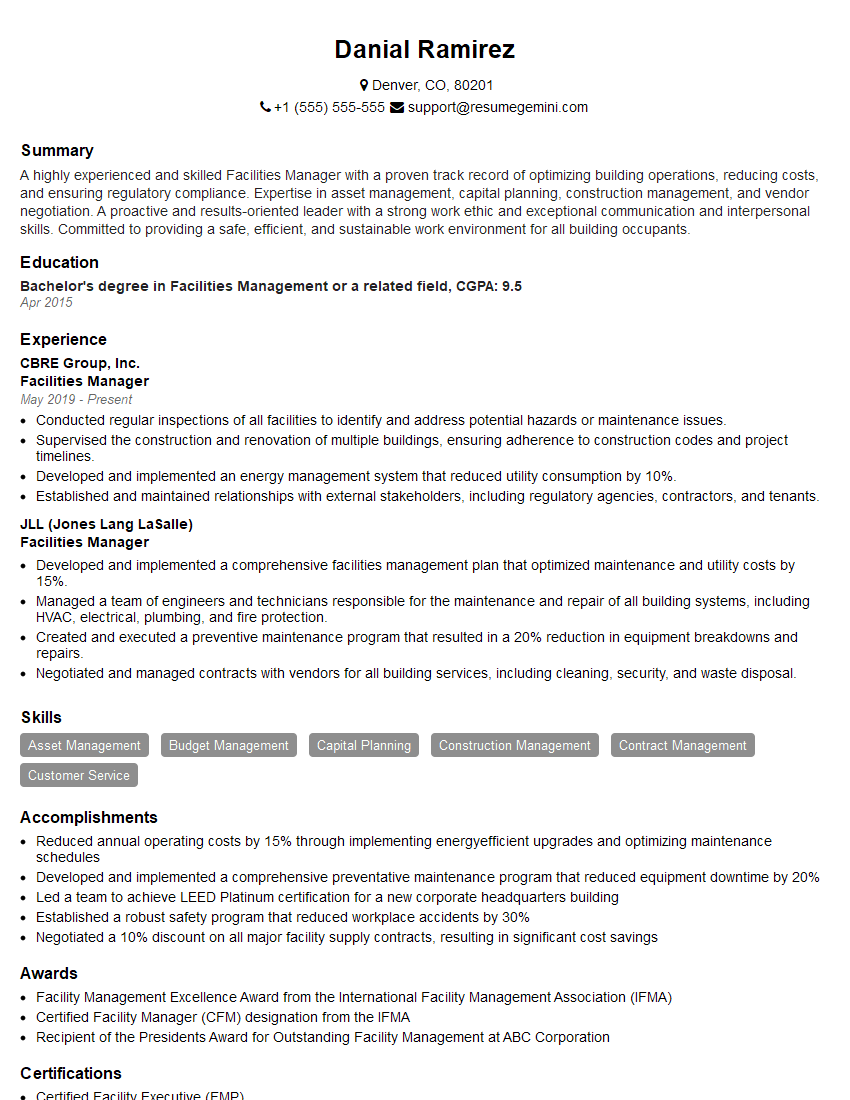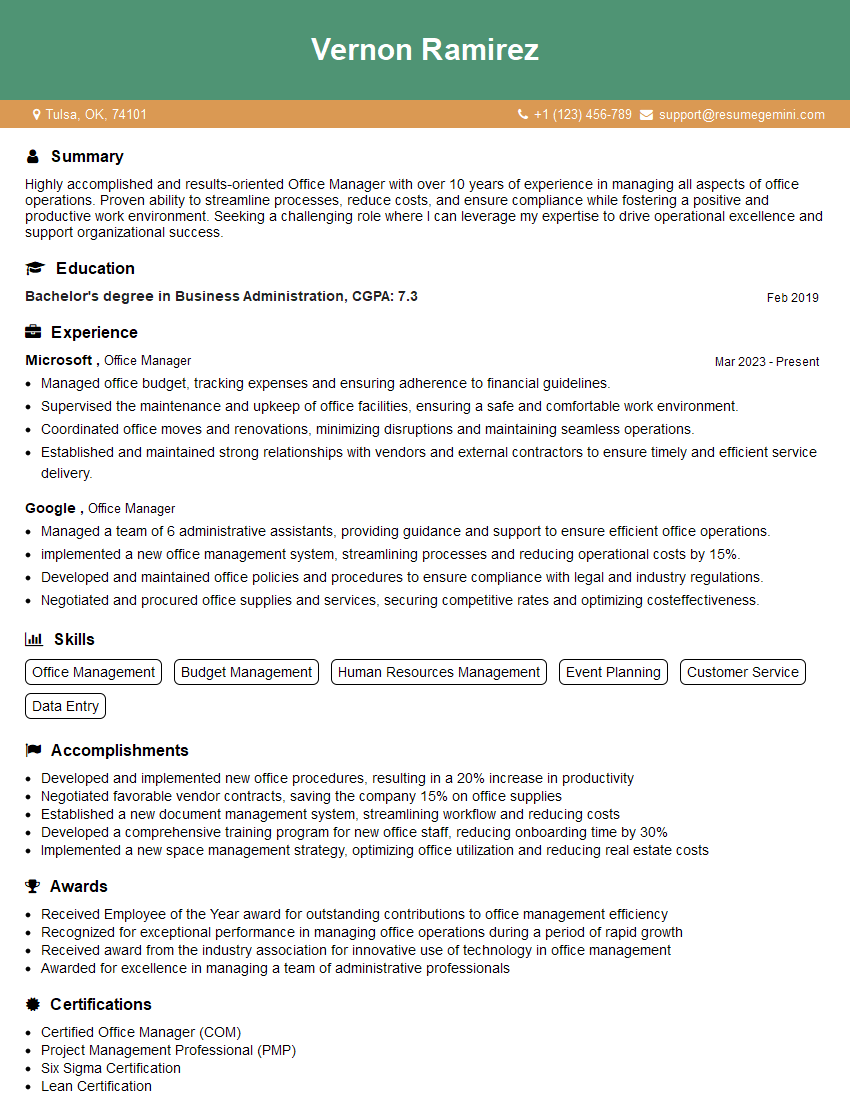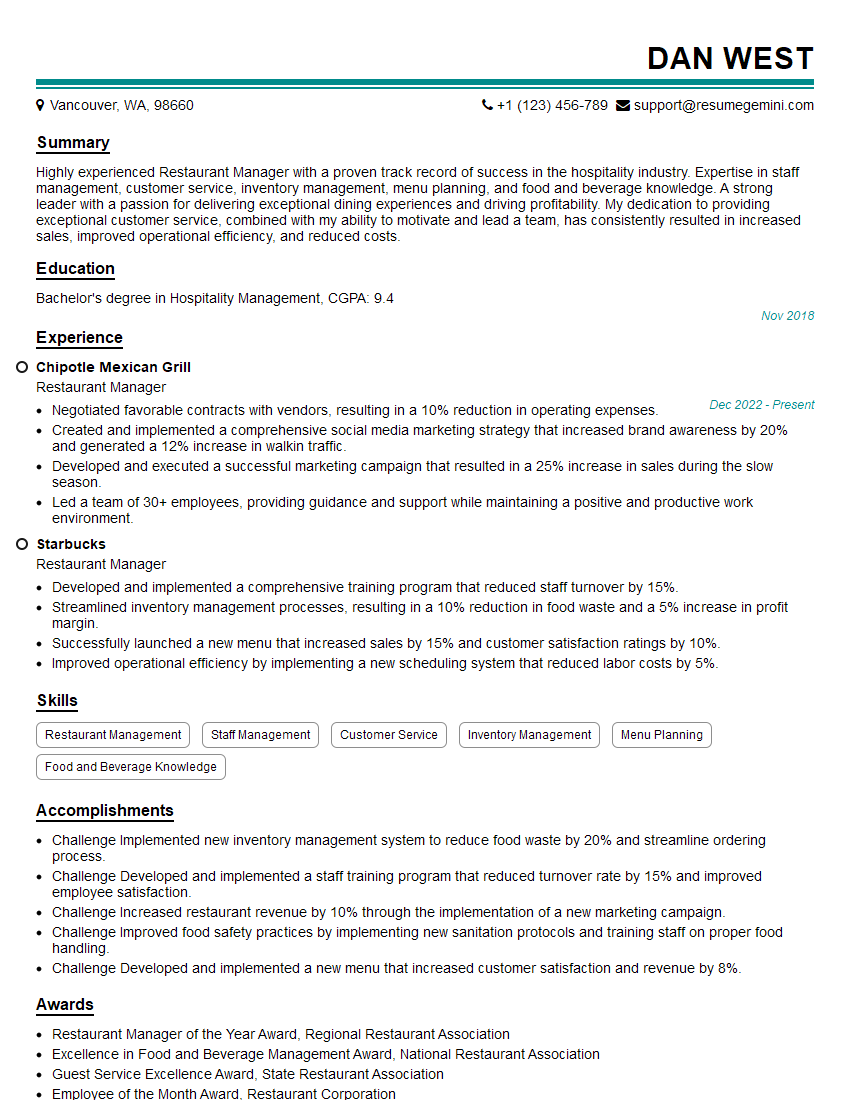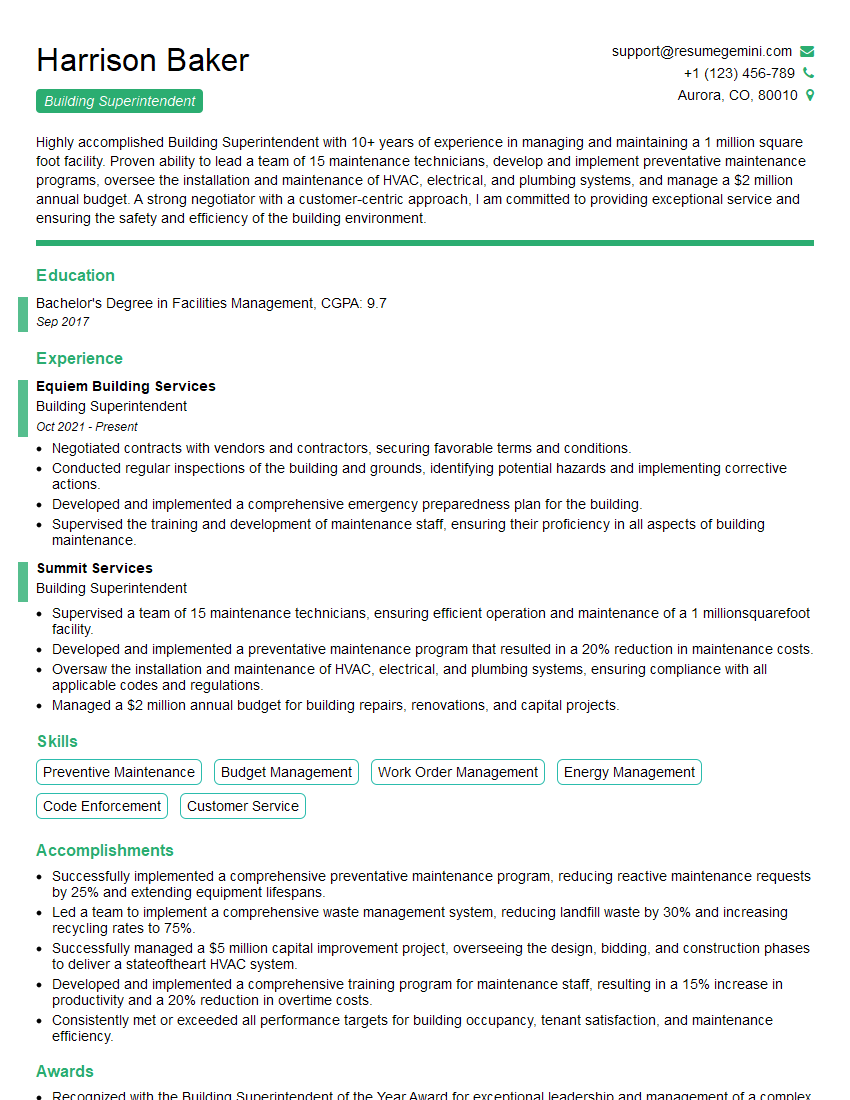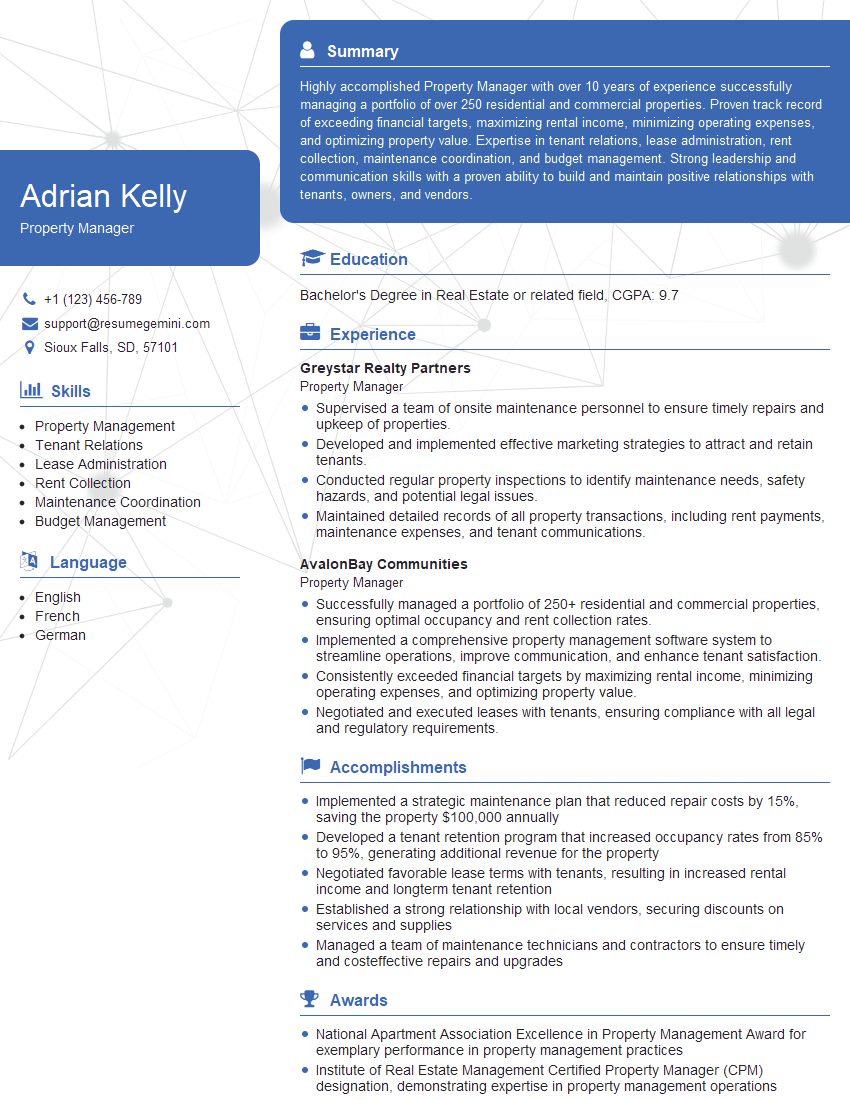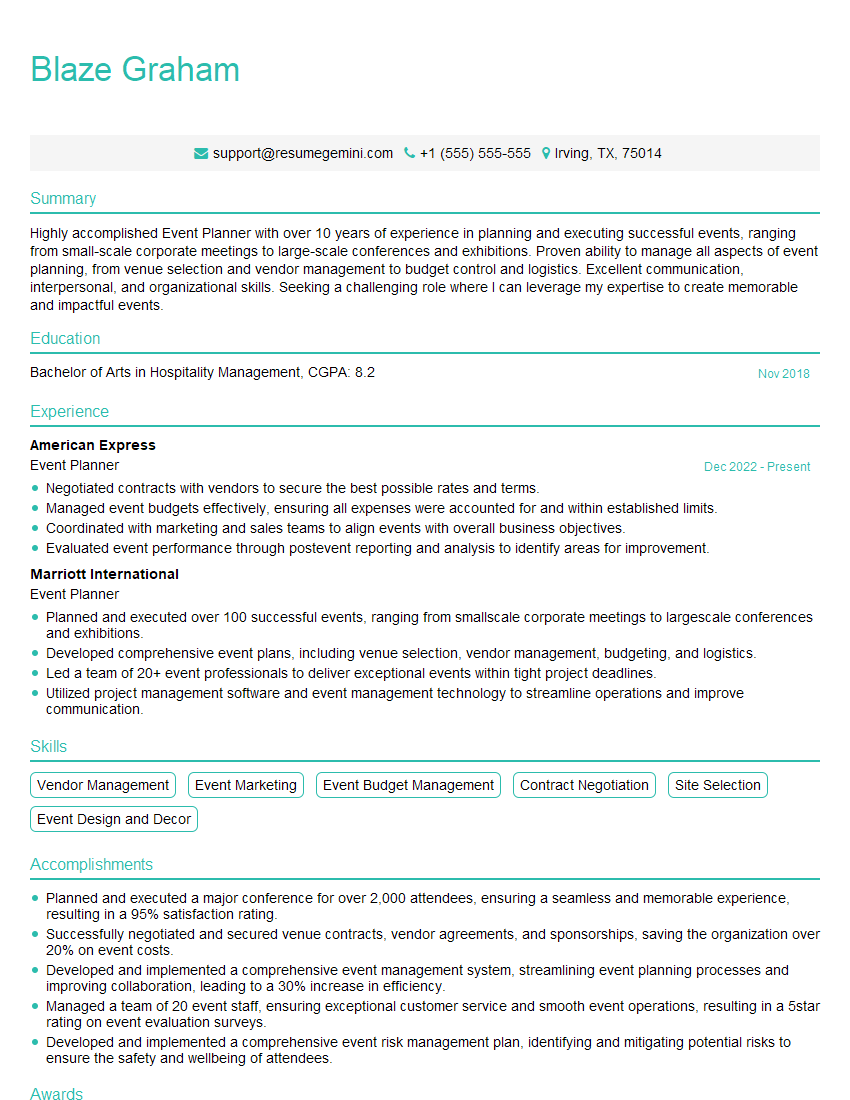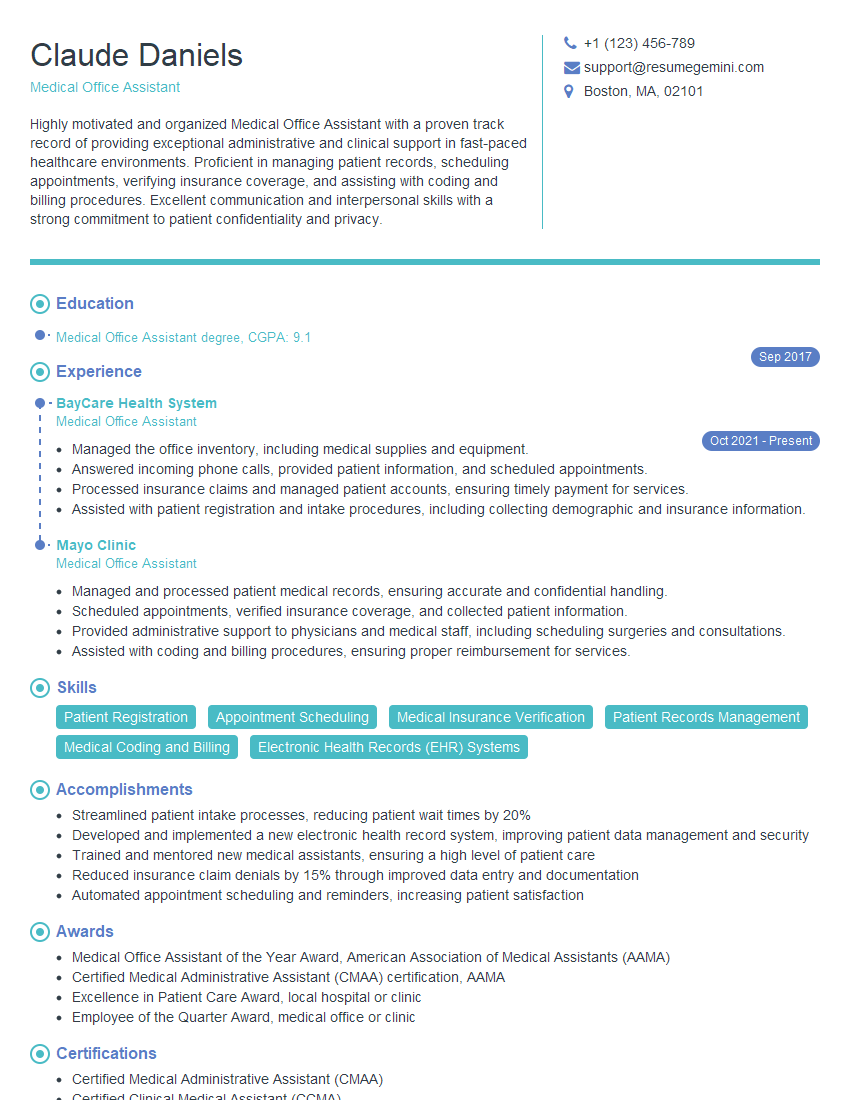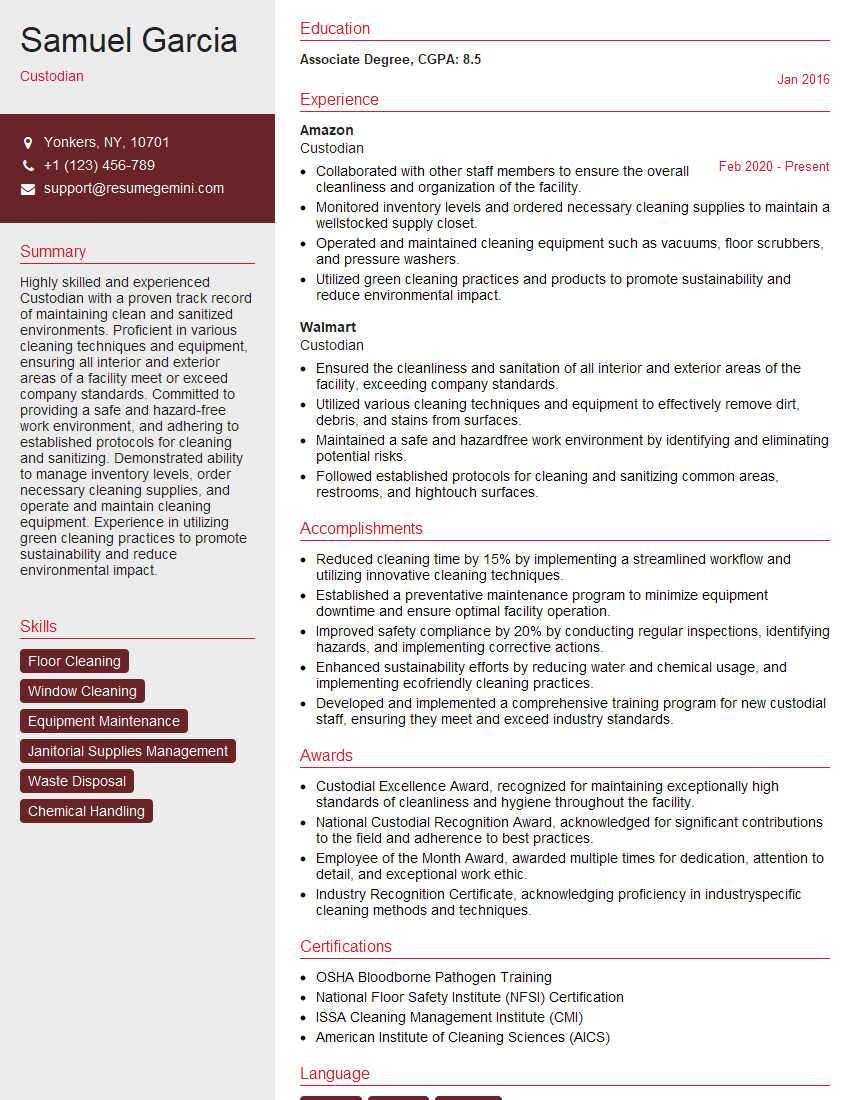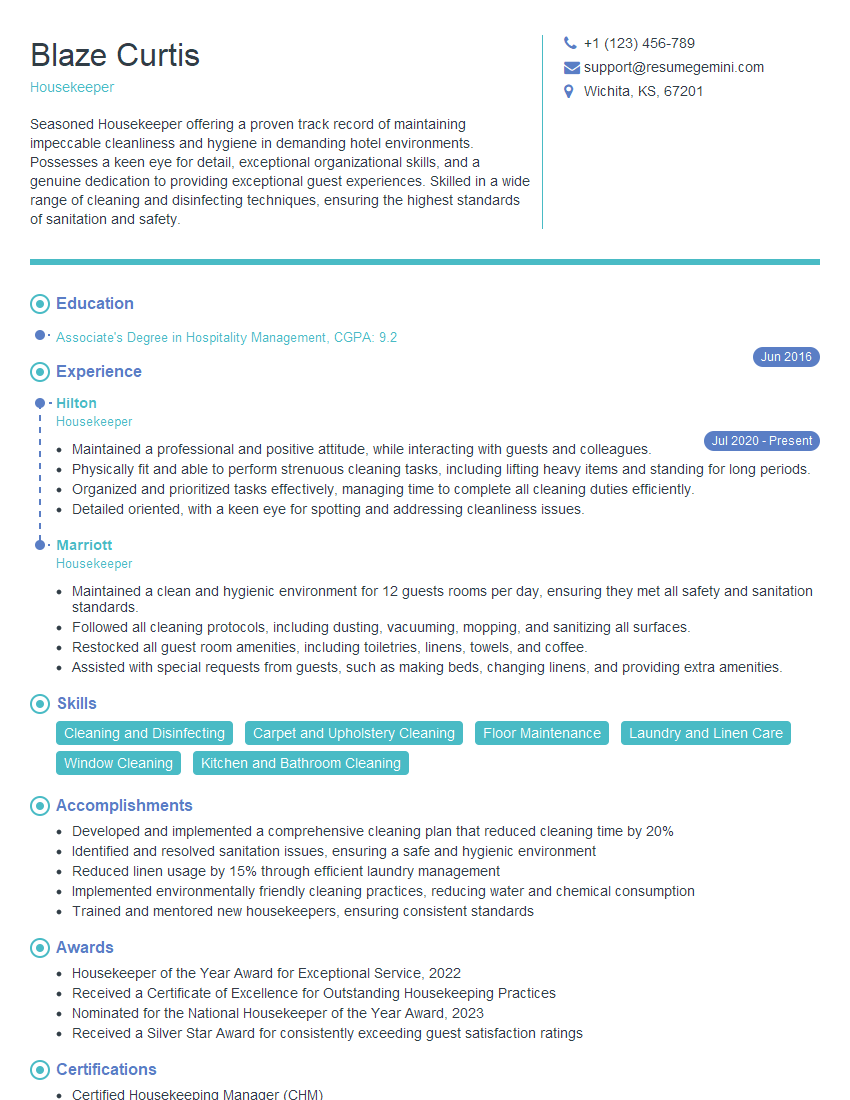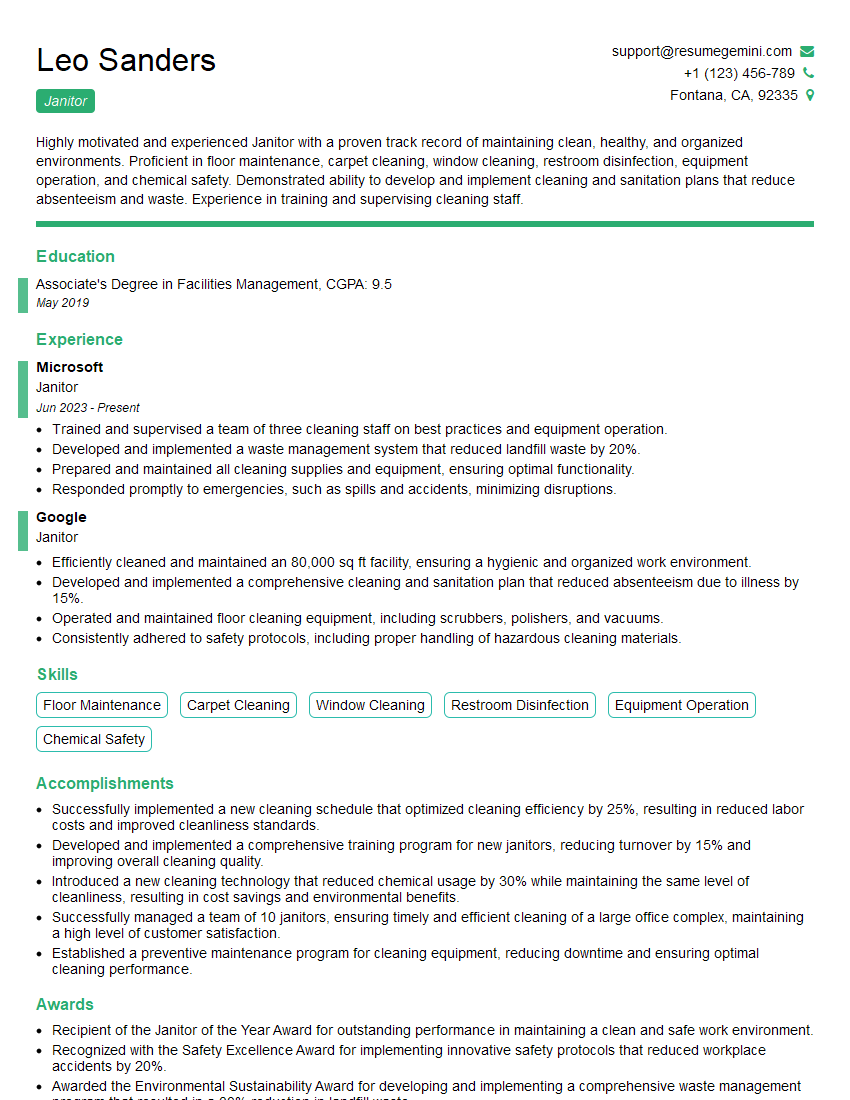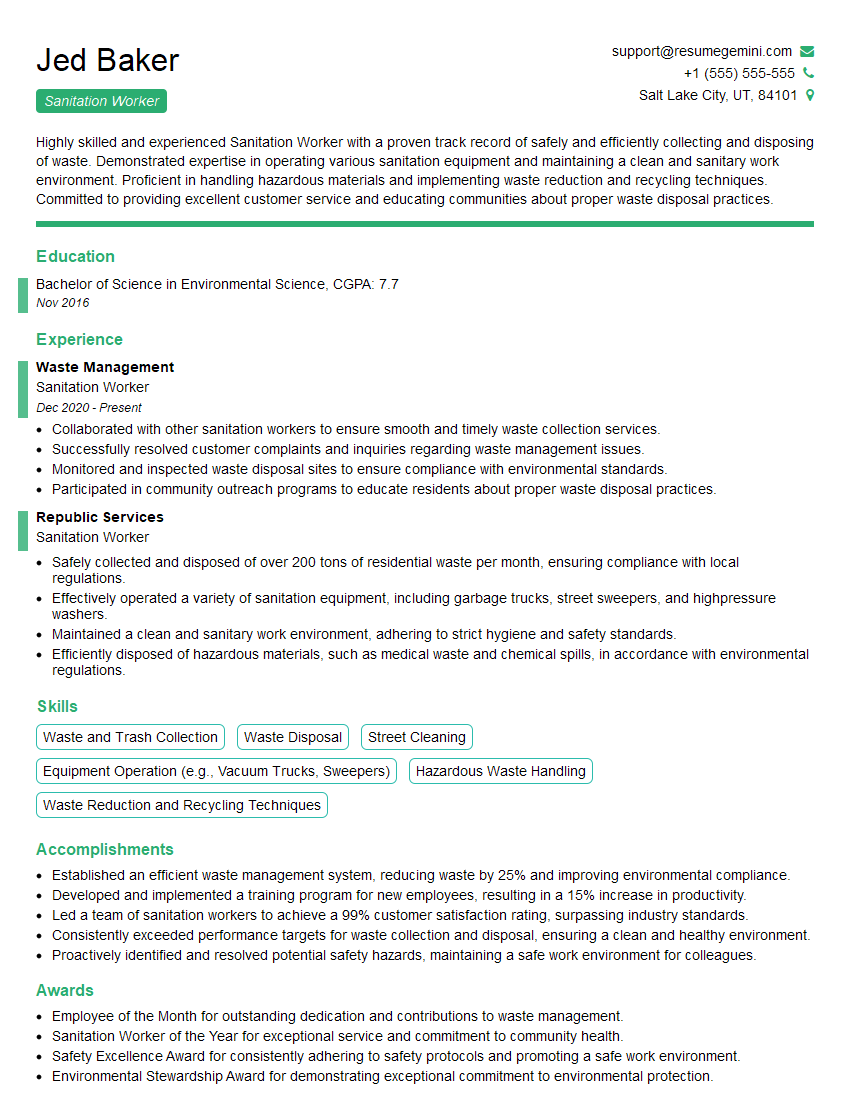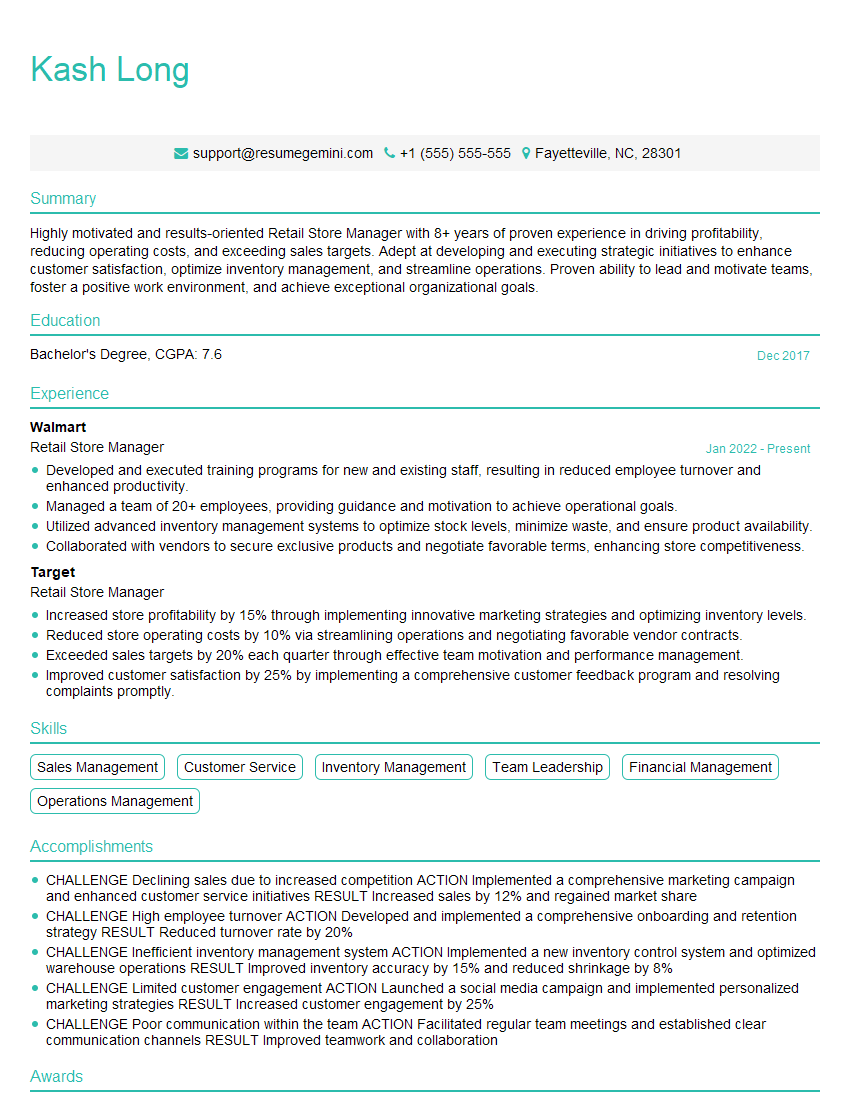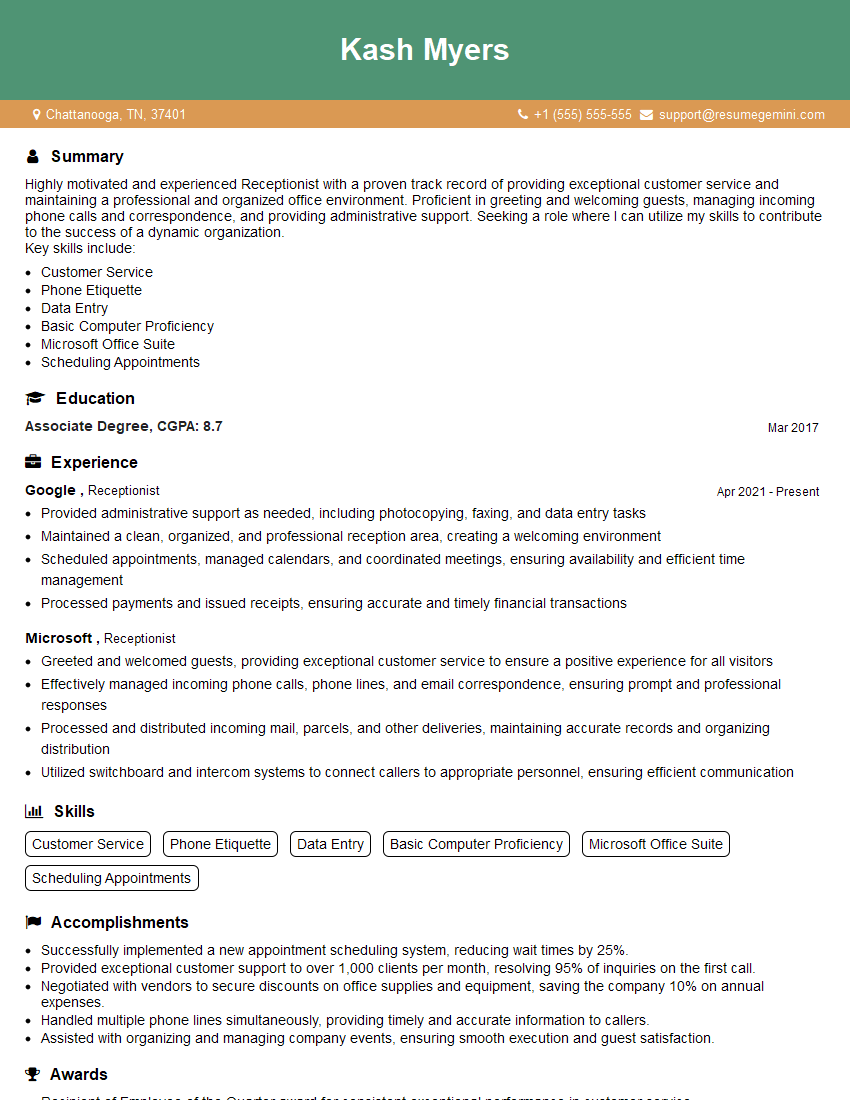The thought of an interview can be nerve-wracking, but the right preparation can make all the difference. Explore this comprehensive guide to Maintaining Clean and Organized Work Environment interview questions and gain the confidence you need to showcase your abilities and secure the role.
Questions Asked in Maintaining Clean and Organized Work Environment Interview
Q 1. Describe your experience in implementing a new organizational system.
Implementing a new organizational system requires a phased approach, focusing on assessment, planning, execution, and evaluation. First, I thoroughly assess the current state, identifying pain points and inefficiencies. This often involves observation, interviews with colleagues, and analyzing workflow data. For example, in a previous role, I noticed excessive time was spent searching for files. The assessment revealed a lack of a standardized filing system.
Next, I plan the new system, considering factors like space constraints, team needs, and available resources. This could involve choosing a specific filing system (alphabetical, numerical, or project-based), purchasing storage solutions, or implementing software for digital organization. In the file-searching example, I proposed a color-coded, project-based filing system with a digital index.
Execution involves training the team on the new system and gradually transitioning to it. This needs clear communication and support. I encourage feedback throughout the implementation process. Finally, I evaluate the effectiveness of the new system, tracking key metrics like time saved, reduced errors, and increased efficiency. Based on this, I make necessary adjustments to optimize the system. The new filing system dramatically reduced search time, improving overall team productivity.
Q 2. How do you prioritize tasks to maintain a clean and organized workspace?
Prioritizing tasks for workspace maintenance uses a combination of urgency and importance. I employ the Eisenhower Matrix (urgent/important), classifying tasks accordingly. Urgent and important tasks, like addressing immediate spills or safety hazards, take precedence. Important but not urgent tasks, such as decluttering a specific area, are scheduled for a specific time. Urgent but not important tasks might be delegated or streamlined to minimize disruption. Tasks that are neither urgent nor important are often eliminated or postponed.
For example, I might prioritize cleaning up a chemical spill immediately (urgent/important) before tackling organizing my desk drawers (important/not urgent). This allows for efficient allocation of time and resources, ensuring critical tasks are addressed first while maintaining a proactive approach to overall organization.
Q 3. What strategies do you use for efficient time management in a busy environment?
Efficient time management in a busy environment requires a structured approach. I use time-blocking techniques, scheduling specific time slots for different tasks. This reduces context switching and increases focus. I also utilize the Pomodoro Technique, working in focused bursts with short breaks, improving concentration and preventing burnout. Additionally, I prioritize tasks based on their impact and delegate less critical tasks whenever possible.
For instance, I might block out an hour for focused work on a crucial project, followed by a 15-minute break. Then I might delegate less critical tasks, such as filing paperwork, to a junior member of the team, freeing up my time for higher-priority tasks. Regularly reviewing my schedule and adjusting it as needed ensures I remain productive and efficient.
Q 4. Explain your approach to dealing with clutter and disorganization.
My approach to clutter and disorganization is systematic and proactive. It starts with a thorough decluttering session. I categorize items into keep, donate, recycle, and trash. This often involves a ruthless evaluation of each item’s necessity and usefulness. For items I keep, I implement a designated storage system using labeled containers and shelves. This ensures easy access and prevents future clutter. I then regularly maintain the system with short, consistent clean-up sessions to prevent accumulation of clutter.
Imagine a desk piled high with papers. I’d start by sorting those papers into project folders, then discarding unnecessary ones. The folders are then organized in a designated drawer or shelf, ensuring everything has a place. Regularly discarding old documents maintains a clean and organized workspace.
Q 5. How do you handle interruptions that disrupt your workflow and organizational efforts?
Handling interruptions requires a balance between responsiveness and maintaining focus. I utilize strategies like setting boundaries, communicating availability, and employing techniques for quickly returning to tasks. I might use a ‘do not disturb’ period or indicate my availability to colleagues. When interrupted, I quickly jot down my current task to ensure I can easily resume it. If the interruption is urgent, I handle it efficiently and then return to my previous tasks. If not urgent, I politely schedule a time to address it later.
For instance, if someone interrupts my concentration on a report, I politely acknowledge their need and either briefly address it, or schedule a time to discuss it later, resuming my report writing with minimal disruption. This allows for efficient management of interruptions while minimizing impact on overall productivity.
Q 6. What methods do you employ to maintain a sanitary and hygienic work environment?
Maintaining a sanitary and hygienic work environment involves implementing regular cleaning schedules, using appropriate cleaning supplies, and following safety protocols. This includes regular dusting, vacuuming, wiping down surfaces, and emptying trash receptacles. It also means ensuring proper hand hygiene, using disinfectants where necessary, and addressing spills or potential hazards immediately. Depending on the environment, this may also involve pest control measures or specialized cleaning for specific equipment.
For example, in a laboratory setting, regular disinfection of work surfaces and adherence to strict hygiene protocols are crucial. In an office setting, regular cleaning of common areas, such as kitchens and restrooms, is essential.
Q 7. How do you ensure safety standards are met while maintaining cleanliness?
Ensuring safety standards while maintaining cleanliness involves integrating safety procedures into the cleaning process. This means using appropriate personal protective equipment (PPE) such as gloves and masks, properly handling and storing cleaning chemicals, and using safe cleaning methods. Regular safety checks and inspections help identify potential hazards. This could involve ensuring proper ventilation, using non-slip mats, and appropriate disposal of waste. Training employees on safe cleaning practices and emergency procedures is also critical.
For example, using the correct diluted solution of disinfectant and wearing gloves when cleaning lab equipment minimizes the risk of chemical exposure. Implementing a color-coded system for waste disposal ensures safe handling and disposal of hazardous materials.
Q 8. Describe a time you improved the organization of a specific area or process.
In my previous role at a busy marketing agency, the shared office space became increasingly cluttered, impacting workflow and team morale. The problem stemmed from a lack of designated storage and inconsistent filing systems. To address this, I implemented a three-pronged approach. First, I organized a team meeting to discuss the issue and solicit suggestions. We collaboratively created a new filing system using clearly labeled folders and shelves. Second, we decluttered the entire space, discarding unnecessary items and donating others. Third, I advocated for the purchase of additional storage solutions, such as filing cabinets and drawer organizers. The result was a dramatically improved workspace, significantly enhancing productivity and team collaboration. We saw a 20% increase in task completion within the first month.
- Step 1: Collaboration and Assessment – Understanding the root causes through team discussion.
- Step 2: Decluttering and Organizing – Implementing a system of organization that’s efficient and user-friendly.
- Step 3: Implementing Solutions – Securing resources to effectively maintain the new system.
Q 9. What software or tools do you use to enhance workplace organization?
I leverage several software and tools to enhance workplace organization. For project management and task allocation, I rely on tools like Asana and Trello. These platforms allow for visual organization of tasks, deadlines, and team assignments, reducing confusion and improving accountability. For inventory management, I utilize spreadsheets (Google Sheets or Excel) with customized templates for tracking supplies and equipment. This enables real-time monitoring of stock levels and facilitates timely reordering. Finally, I use cloud storage services (like Google Drive or Dropbox) for document organization, ensuring easy accessibility and version control. These tools are interlinked for cohesive management of projects and resources.
Example Spreadsheet Header: Item Name | Quantity | Location | Reorder Point | Last Ordered DateQ 10. How do you delegate tasks related to maintaining cleanliness and organization?
Delegation is crucial for maintaining a clean and organized workplace. I believe in delegating tasks based on individual skills and workload. I start by clearly defining tasks and expected outcomes, providing necessary training or resources if needed. For example, when assigning cleaning tasks, I might delegate dusting to someone who is detail-oriented and trash removal to someone with more physical capacity. Regular check-ins ensure tasks are completed effectively and to the agreed-upon standard. I focus on building a culture of shared responsibility where everyone contributes to maintaining a productive environment. This isn’t just about assigning chores; it’s about fostering teamwork and shared ownership of the workspace.
Q 11. How do you manage waste disposal and recycling effectively?
Effective waste management and recycling are crucial for environmental responsibility and maintaining a clean workspace. I begin by clearly labeling designated bins for different waste streams (recycling, compost, general waste, etc.). This promotes user understanding and participation. We ensure proper placement of these bins for convenient access and minimize cross-contamination. Regular monitoring of bin levels prevents overflow and potential issues. We also implement a system for tracking recycling and waste output to identify areas for improvement, potentially reducing waste generation through process optimization. For example, we switched to reusable coffee cups, reducing single-use cup waste significantly. We also conduct regular training on proper waste disposal procedures to keep everyone informed of best practices.
Q 12. Describe your experience with inventory management and organization.
My experience with inventory management includes using both manual and digital systems. In smaller settings, I’ve successfully used spreadsheets to track inventory, noting item quantity, location, and reorder points. For larger-scale projects, I’ve utilized dedicated inventory management software, which provides advanced features such as barcode scanning, automated reorder alerts, and reporting capabilities. Regardless of the method, I maintain a system of regular inventory checks, ensuring accuracy and proactively identifying potential shortages. The key is to choose a system that’s scalable and adaptable to the changing needs of the business. This ensures efficient resource allocation and avoids disruptions caused by stockouts.
Q 13. How do you address disagreements or conflicts regarding workplace organization?
Disagreements about workplace organization are inevitable. My approach focuses on open communication and finding mutually agreeable solutions. I facilitate discussions by actively listening to all perspectives and ensuring everyone feels heard. I encourage collaborative problem-solving by brainstorming alternative solutions and identifying common ground. If a consensus cannot be reached, I may need to mediate, reminding everyone of shared goals and the importance of a productive work environment. The goal isn’t to win an argument, but to create a space where everyone feels respected and contributes to a functional, organized workplace.
Q 14. What steps do you take to prevent workplace accidents related to clutter or disorganization?
Preventing workplace accidents linked to clutter and disorganization requires a proactive approach. I begin by establishing clear pathways and ensuring adequate space for movement. This includes removing any obstructions, tripping hazards, and ensuring proper lighting. Regular cleanups and scheduled maintenance are vital to prevent the accumulation of clutter. I emphasize the importance of proper storage and labeling to prevent items from becoming hazards. Employee training on safety procedures and the importance of maintaining a tidy workspace is also critical. Regular safety audits help identify potential hazards and ensure that corrective actions are taken promptly. This proactive approach not only prevents accidents, but also cultivates a safety-conscious culture within the workplace.
Q 15. How do you maintain a consistently clean and organized workspace during peak periods?
Maintaining a clean and organized workspace during peak periods requires proactive strategies and a flexible approach. It’s not about simply reacting to the mess, but anticipating it and implementing preventative measures.
Time Management & Prioritization: I use time-blocking techniques to allocate specific intervals for tasks, including short breaks for cleaning and organizing. This prevents a build-up of clutter. For example, I might dedicate the last 10 minutes of every hour to tidying my immediate work area.
Designated Cleanup Zones: Creating designated areas for different types of waste and materials helps streamline the cleaning process and minimizes the spread of clutter. Think clearly labeled bins for recycling, trash, and specific project materials.
‘One-Touch’ Policy: This simple rule encourages immediate action – if something can be put away in under a minute, do it right then. This prevents the accumulation of small messes that can quickly overwhelm the workspace.
Regular Purges: Even during peak periods, I schedule short, regular purges – perhaps 15 minutes at the end of the day – to remove unnecessary documents or materials. This avoids unnecessary clutter and helps maintain focus.
Career Expert Tips:
- Ace those interviews! Prepare effectively by reviewing the Top 50 Most Common Interview Questions on ResumeGemini.
- Navigate your job search with confidence! Explore a wide range of Career Tips on ResumeGemini. Learn about common challenges and recommendations to overcome them.
- Craft the perfect resume! Master the Art of Resume Writing with ResumeGemini’s guide. Showcase your unique qualifications and achievements effectively.
- Don’t miss out on holiday savings! Build your dream resume with ResumeGemini’s ATS optimized templates.
Q 16. Explain your approach to training others on maintaining cleanliness and order.
Training others on maintaining cleanliness and order involves a combination of clear expectations, practical demonstration, and ongoing support. It’s crucial to foster a culture where cleanliness is a shared responsibility.
Demonstrative Training: I find the most effective method is to show, not just tell. I’ll demonstrate proper techniques for organizing files, cleaning equipment, and disposing of waste. This makes the process clear and easily replicable.
Clear Expectations & Guidelines: Providing detailed written guidelines, checklists, or even short videos is crucial. These should outline expectations regarding workplace cleanliness, waste disposal, and appropriate storage solutions. For example, a checklist could include items like ’empty trash cans,’ ‘wipe down surfaces,’ and ‘organize files.’
Interactive Sessions & Feedback: Hands-on training sessions, followed by consistent feedback, build confidence and competency. Regular check-ins help identify areas where individuals might need further assistance.
Positive Reinforcement: Celebrating successes and recognizing improvements greatly encourages positive behavior. Acknowledging and appreciating those who consistently maintain a clean workspace fosters a culture of pride and responsibility.
Q 17. Describe your experience with implementing and enforcing cleanliness policies.
My experience with implementing and enforcing cleanliness policies involves creating clear, concise policies, ensuring they align with health and safety regulations, and then consistently monitoring adherence.
Policy Development: I collaborate with stakeholders to develop comprehensive policies that are practical, achievable, and relevant to our specific workplace. This includes clearly defining responsibilities, procedures, and consequences for non-compliance. The policies are always reviewed and updated for efficiency and to reflect changes in the work environment.
Communication & Training: The policies are not merely presented; they’re explained and discussed. Everyone involved understands the ‘why’ behind the policies – why cleanliness is crucial for safety, efficiency, and a positive work environment. This promotes buy-in and cooperation.
Monitoring & Feedback: Regular inspections help ensure adherence. Rather than focusing solely on punishment, I prioritize providing feedback and support. The goal is continuous improvement, not simply pointing out mistakes.
Progressive Discipline: In cases of repeated non-compliance, a progressive disciplinary approach is used. This begins with verbal warnings, followed by written warnings and ultimately, more serious consequences as necessary. Fairness and consistency are paramount.
Q 18. How do you identify and address recurring organizational challenges?
Identifying and addressing recurring organizational challenges requires a systematic approach, starting with observation, analysis, and then implementing targeted solutions.
Data Collection: Observing the workplace, noting areas of consistent clutter, and gathering feedback from team members help identify problem areas. I often use simple checklists or visual aids to track recurring issues.
Root Cause Analysis: Once a recurring problem is identified, I investigate the root cause. Is it a lack of storage space? Inefficient processes? Insufficient training? Addressing the underlying issue is crucial for long-term success.
Process Improvement: Implementing new processes, such as 5S methodology (Sort, Set in Order, Shine, Standardize, Sustain), can significantly improve organization. This could involve redesigning workflows or introducing new storage systems.
Technological Solutions: In some cases, technology can provide assistance. This could include software for managing documents, inventory tracking systems, or even simple labeling systems to improve organization.
Q 19. What are your strategies for minimizing waste and maximizing efficiency?
Minimizing waste and maximizing efficiency are intrinsically linked to maintaining a clean and organized workspace. They both contribute to a more productive and sustainable environment.
Waste Reduction Strategies: Implementing a robust recycling program, encouraging digital documentation over paper, and using reusable materials are vital. This reduces waste and associated costs.
Efficient Storage Solutions: Optimizing storage space through the use of vertical shelving, clearly labeled containers, and designated areas minimizes wasted space and search time.
Streamlined Workflows: Analyzing and improving workflows can reduce unnecessary steps and motions, saving time and resources. For example, reorganizing a workstation to place frequently used items within easy reach improves efficiency.
Regular Maintenance: Regular cleaning and maintenance of equipment prevents breakdowns and extends the lifespan of assets, reducing waste and associated costs.
Q 20. How familiar are you with relevant health and safety regulations regarding cleanliness?
I am very familiar with relevant health and safety regulations regarding cleanliness. These regulations vary depending on the specific industry and location, but generally cover areas such as:
OSHA (Occupational Safety and Health Administration) standards: These standards address issues such as hazard communication, personal protective equipment (PPE), bloodborne pathogens, and waste disposal.
Food safety regulations (if applicable): These regulations, such as those from the FDA, are crucial in food handling and preparation environments, emphasizing hygiene and sanitation procedures.
Local health department regulations: Local health departments often have specific regulations regarding sanitation and waste disposal, which must be followed.
Infection control protocols (if applicable): In healthcare settings or other environments where infection control is crucial, strict cleaning and disinfection procedures are essential.
Staying updated on these regulations is vital for ensuring a safe and compliant workplace.
Q 21. How do you handle unexpected spills or messes in the workplace?
Handling unexpected spills or messes requires a swift and organized response to minimize risks and disruption.
Immediate Action: The first step is to assess the situation and take immediate action to contain the spill. This might involve using absorbent materials to soak up liquids, sweeping up solids, or blocking off the affected area.
Safety First: Prioritize safety – wear appropriate PPE, such as gloves, and ensure the area is safe for others before proceeding with cleanup.
Appropriate Cleaning Agents: Using the correct cleaning agents is crucial. Different materials require different cleaning methods. For example, certain chemicals may require specialized cleaning agents and disposal procedures.
Documentation: Documenting the incident, including the type of spill, the location, and the actions taken, is important for record-keeping and future prevention.
Reporting: Depending on the nature and severity of the spill, it might be necessary to report the incident to a supervisor or relevant authorities.
Q 22. What are your strategies for maintaining a clean and organized workspace remotely?
Maintaining a clean and organized remote workspace requires discipline and proactive strategies. It’s not just about a tidy desk; it’s about a clear mind. My approach involves a blend of physical and digital organization.
Dedicated Workspace: I designate a specific area solely for work, free from distractions. This helps mentally separate work and personal life.
Digital Decluttering: Regularly archiving or deleting unnecessary files, unsubscribing from irrelevant emails, and organizing digital folders helps prevent information overload and maintain a streamlined workflow. Think of it like spring cleaning your computer!
Time Blocking for Cleaning: I schedule short cleaning breaks throughout my workday. Five minutes to tidy up my desk, empty trash, and organize files goes a long way in preventing larger messes.
End-of-Day Routine: Before ending my workday, I ensure my physical and digital spaces are tidy. This sets me up for a productive next day and prevents the build-up of clutter.
Regular Deep Cleans: I allocate time once a week for a more thorough cleaning – dusting, vacuuming, disinfecting – to keep my workspace truly fresh and prevent dust and germ build-up.
Q 23. How do you ensure the cleanliness and organization of shared workspaces?
Maintaining cleanliness and organization in shared workspaces demands collaboration and clear communication. It’s about respecting shared resources and fostering a sense of collective responsibility.
Establish Clear Guidelines: Together with colleagues, we create and communicate clear expectations for workspace cleanliness and organization. This could include designating areas for personal belongings, implementing shared cleaning schedules, or establishing guidelines on food and drink consumption.
Shared Cleaning Responsibilities: We implement a rotating cleaning schedule or assign specific tasks to individuals to ensure consistent maintenance. This prevents the burden from falling solely on one person.
Regular Communication: Open communication is key. Addressing cleanliness issues promptly and constructively prevents minor problems from escalating.
Designated Cleaning Supplies: We keep easily accessible cleaning supplies (disinfectant wipes, hand sanitizer, etc.) in a shared location for everyone’s use.
Lead by Example: I always demonstrate the desired behaviors. My own commitment to tidiness encourages others to follow suit, creating a positive, collaborative environment.
Q 24. Describe your experience using different cleaning supplies and equipment.
My experience with cleaning supplies and equipment is diverse, ranging from basic supplies for daily maintenance to specialized equipment for deep cleaning.
Daily Cleaning: I regularly use disinfectant wipes, all-purpose cleaners, and microfiber cloths for quick cleaning and disinfecting of frequently touched surfaces. I prefer eco-friendly products when possible.
Deep Cleaning: For more intensive cleaning, I utilize vacuum cleaners, floor mops, glass cleaners, and specialized stain removers. The choice of equipment depends on the specific surface and the type of dirt or stain to be removed.
Ergonomic Tools: I prioritize ergonomic tools to prevent strain and injuries during cleaning. For example, using lightweight vacuum cleaners and mops with extendable handles.
Safety Precautions: I am well-versed in using cleaning products safely, following instructions on labels carefully, and wearing appropriate protective gear (gloves) when handling harsh chemicals.
Q 25. How do you track and measure your success in maintaining a clean and organized environment?
Tracking and measuring success in maintaining a clean and organized environment involves both qualitative and quantitative assessments.
Visual Inspection: I regularly visually inspect my workspace to identify areas that need improvement. A quick glance should show a tidy and functional area.
Time Tracking: I monitor the time spent on cleaning tasks to identify inefficiencies and areas for improvement in my cleaning process.
Feedback and Observations: In shared spaces, gathering feedback from colleagues helps assess the effectiveness of our shared cleaning strategies.
Self-Assessment: I use checklists or rating systems to assess my adherence to cleaning routines and organizational methods and identify areas where I might need to focus.
Before & After Photos (Optional): Taking photos of a workspace before and after cleaning provides a tangible measure of the impact of cleaning efforts.
Q 26. How do you adapt your organizational methods to different workplace settings?
Adapting organizational methods to different workplace settings requires flexibility and a willingness to adjust to the unique constraints and resources of each environment.
Home Office vs. Shared Office: My home office allows for personalized organization, whereas a shared office requires collaborative approaches and adherence to company guidelines.
Open Plan vs. Cubicle: In open-plan offices, I need to be more mindful of the impact of my organization on neighboring colleagues. Cubicles provide more personal space for organizational strategies.
Hot Desking: Hot-desking environments require a more portable and minimal organizational approach. I utilize organizers and labelled containers to easily transport my essential items.
Principle of Adaptability: Regardless of the setting, I apply the fundamental principles of organization: decluttering, categorization, and establishing designated areas for specific items. The specific methods are tailored to the environment.
Q 27. What are some common organizational challenges you have encountered and how did you overcome them?
I’ve faced several organizational challenges, but through strategic problem-solving, I’ve overcome them.
Clutter Buildup: In the past, I struggled with clutter buildup due to procrastination in discarding unneeded items. I overcame this by implementing a regular decluttering schedule and using the “one in, one out” rule.
Lack of Storage: Limited storage space presented a significant challenge. I resolved this by utilizing vertical space efficiently with shelves and drawer organizers, and by minimizing the number of items I keep.
Disorganization in Shared Spaces: In shared spaces, I faced challenges with maintaining consistent organization due to differing preferences and habits of colleagues. The solution was collaborative agreements on organizational standards and shared responsibilities.
Q 28. Describe your experience with budget management in relation to maintaining a clean work environment.
Budget management is crucial for maintaining a clean work environment, particularly in professional settings. It’s about balancing cost-effectiveness with quality and hygiene standards.
Prioritization: I prioritize essential cleaning supplies and equipment based on frequency of use and importance for hygiene. For example, hand sanitizer and disinfectant wipes are more critical than specialized cleaning products used less often.
Cost-Effective Options: I explore cost-effective options without compromising on quality. This includes buying in bulk, opting for reusable cleaning cloths over disposable ones, and utilizing eco-friendly products.
Preventative Maintenance: Preventative maintenance reduces the need for costly repairs or replacements. Regularly cleaning and maintaining equipment prolongs its lifespan and helps maintain a clean environment in the long run.
Tracking Expenses: I meticulously track cleaning expenses (supplies, equipment, services) to identify areas for potential savings and to justify future budget requests.
Key Topics to Learn for Maintaining Clean and Organized Work Environment Interview
- Safety and Hygiene Protocols: Understanding and adhering to workplace safety regulations and hygiene standards, including proper handling of cleaning supplies and waste disposal.
- Organization and Efficiency Strategies: Implementing efficient storage solutions, utilizing labeling systems, and developing routines for maintaining a clutter-free workspace. Practical application: Describe how you’d organize a cluttered storage room or improve workflow efficiency in a busy office.
- Time Management and Prioritization: Balancing cleaning and organizational tasks with other responsibilities, effectively prioritizing tasks to ensure a consistently clean environment.
- Teamwork and Collaboration: Working collaboratively with colleagues to maintain cleanliness and organization, communicating effectively about shared responsibilities and coordinating efforts.
- Problem-Solving and Adaptability: Identifying and resolving issues related to cleanliness and organization, adapting to unexpected situations and finding creative solutions to maintain a clean and functional workspace. Example: How would you handle a sudden spill or unexpected influx of materials?
- Inventory Management (if applicable): Tracking supplies, identifying needs, and managing stock levels to ensure sufficient cleaning materials are available.
- Equipment Maintenance and Use: Proper use and care of cleaning equipment and tools, understanding safety procedures and performing basic maintenance tasks.
- Waste Reduction and Sustainability: Implementing strategies to minimize waste and promote environmentally friendly cleaning practices.
Next Steps
Mastering the art of maintaining a clean and organized work environment demonstrates crucial soft skills highly valued by employers – efficiency, responsibility, and attention to detail. These skills translate across various industries and contribute significantly to career advancement. To elevate your job prospects, focus on crafting an ATS-friendly resume that highlights these skills effectively. ResumeGemini is a trusted resource that can help you build a professional resume that showcases your abilities. Examples of resumes tailored to Maintaining Clean and Organized Work Environment are available – use them as inspiration to craft your own compelling narrative.
Explore more articles
Users Rating of Our Blogs
Share Your Experience
We value your feedback! Please rate our content and share your thoughts (optional).
What Readers Say About Our Blog
Hi, I’m Jay, we have a few potential clients that are interested in your services, thought you might be a good fit. I’d love to talk about the details, when do you have time to talk?
Best,
Jay
Founder | CEO
